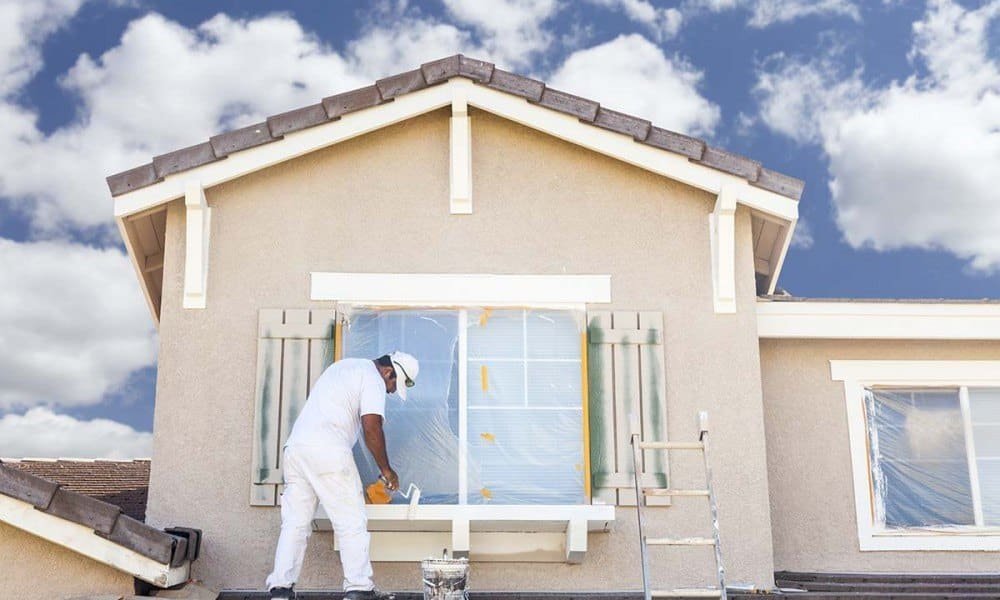When it comes to painting the exterior of your house, proper prep work is vital. It’s what makes your new paint job look great and last longer.
Exterior house painting services include inspecting the home for rotten wood, cracks in plaster, and loose siding. It also includes cleaning the surface with a power washer and adding a solution to kill mold and mildew.
Preparing the Surface
When it comes to exterior painting, preparing the surface is one of the most important parts of the process. This includes cleaning, repairing damaged surfaces, and priming the area before painting begins. Properly preparing the surface ensures that the new paint will adhere to the surface, last longer, and look better.
Getting the surface ready for painting starts with washing the entire area to be painted. This removes loose paint, dirt, mildew, and other debris that can prevent a fresh coat of paint from adhering to the surface. Sometimes, a contractor may use a high-pressure washer to wash the surface. In other cases, it may be done by hand using a scrub brush and cleaning solution.
Sanding the surface to remove any rough patches is the next stage in the preparation procedure. Depending on the surface’s condition, this can be done manually or with a power sander. For this phase, often, a coarse grit of sandpaper is utilized. A finer grit can also be employed in some circumstances.
Aside from sanding, a quality painting contractor will repair any cracks or chips in the surface. This can be done with wood putty or epoxy filler allowed to dry. In some cases, this can even include putting a patch on a hole in the wall or other surface that will be painted.
Repairing Cracks or Damage
The first step in a great paint job is washing the surfaces since surface impurities inhibit effective adherence. Professional painters will take their time getting the space ready for painting since they understand how important this phase is. Additionally, they will see that any fractures or damage are fixed. This will make it possible to guarantee that the new paint job suits the season.
Cracking is a common problem when the paint film separates from the substrate. This can be caused by weathering, aging, or improper application. It can also be the result of poor ventilation or moisture penetration. This problem can be corrected by brushing the loose paint and sanding the affected area. It is then important to spot prime and repaint the bare area.
Another common problem is the appearance of mildew or mold on the painted surface. Sometimes, this can be caused by clogged gutters not channeling water away from the house. This can cause stains on the exterior paint that can be difficult to remove. The culprit may be a leaking flashing at a chimney or another wall/roof intersection.
To prevent this type of problem, it is best to have the gutters cleaned regularly. It is also a good idea to check all the caulking around the home and replace any that has deteriorated. This will help keep the moisture out of the walls and protect the wood substrates.
Choosing the Right Primers
Primers are available in various formulations that work with different surfaces and paints. A well-established paint retailer can help you decide which will work best for your surface and the paint you plan to use on top.
Using a primer is not required in some situations, but it’s a good idea for most new painting projects. Using a primer will allow the paint to adhere to the surface better, helping prevent peeling and flaking. Primer also seals cracks and pores in the surface, allowing for a smoother finish.
If you’re painting over a previous dark color, it can often take multiple coats of light paint to hide the old color. A tinted primer can help reduce the coats needed to achieve even coverage, saving time and money on materials.
There are some different types of primers for wood surfaces, including oil-based and alkyd-based options. Some are formulated to work with specific surfaces, such as redwood and cedar, while others are designed for particular areas of the country. For example, in California, where VOC regulations are a major consideration, many professionals prefer water-based stain-blocking primers to block tannin bleed from these wood species. These products are low in toxic fumes and dry quickly. They are a good choice for older wood that may have been stained with solvent-based staining agents like crayon, grease, or ink.
Choosing the Right Paint
Exterior paint serves two major functions; beautify and protect. It stands up to harsh weather elements that damage a home, including rain, freezing temperatures, blazing sun, and wind. It is a thin liquid that creates an average of 1-2 mils of protective coating. That is a lot of protection for your investment.
When selecting paint colors, it is important to consider the home’s architectural style, surrounding buildings, and natural surroundings. The color must fit the environment without being too loud or clashing. Choosing the right paint will enhance your home’s curb appeal and increase its value. According to the International House Painting Association, a well-maintained home with a fresh coat of paint can sell for up to 10 percent more than similar properties that have not been painted.
It is also important to properly prepare the surface before beginning your project. This includes repairing cracks and other damage, washing the surfaces, and priming where necessary. This will ensure the new paint job looks great and lasts a long time. A professional painting contractor has the skills and experience to complete these tasks correctly and quickly. This can save you time and money in the long run. If you are considering painting your home’s exterior, contact a professional to estimate and discuss the best colors for your property.







